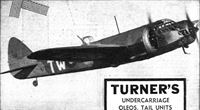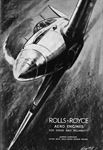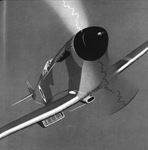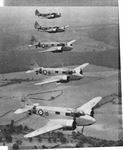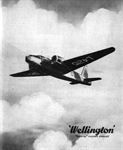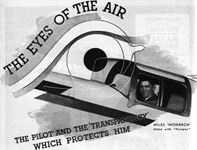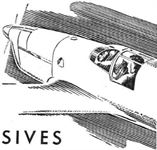Фотографии
-
Регистрационный номер: K7058 Самолёты на фотографии: Bristol Blenheim - Великобритания - 1936
-
The difference between the first fragile “Bristol” aeroplanes of 1910 and the modern all-metal “Bristol” monoplane, represents 29 years of aircraft production, research and development. From the first "Bristol" Boxkites of 1910 to the famous “Bristol” Fighter which, in 1917, gave the Allies supremacy in the air; and so to the equally famous "Bristol" Blenheim Bomber, the first all-metal stressed-skin cantilever monoplane to go into quantity production for the Royal Air Force, "Bristol" development has made aviation history.
Самолёты на фотографии: Bristol Blenheim - Великобритания - 1936Bristol F.2A/F.2B Fighter - Великобритания - 1916
-
Самолёты на фотографии: Bristol Blenheim - Великобритания - 1936
-
Самолёты на фотографии: Hawker Hurricane - Великобритания - 1935
-
Самолёты на фотографии: Supermarine Spitfire - Великобритания - 1936
-
Самолёты на фотографии: Supermarine Spitfire - Великобритания - 1936
-
Самолёты на фотографии: North American T-6 Texan / AT-6 Harvard - США - 1935
-
The Battle is typical modern stressed-skin type.
Самолёты на фотографии: Fairey Battle - Великобритания - 1936
-
Самолёты на фотографии: Fairey Battle - Великобритания - 1936
-
Регистрационный номер: G-ADHJ, G-ADHK Самолёты на фотографии: Short Mayo Composite (S.20 Mercury and S.21 Maia) - Великобритания - 1938
-
Самолёты на фотографии: Boulton Paul Defiant / P.82 - Великобритания - 1937
-
DOWTY SHOCK ABSORBER WHEEL fitted to a Miles Magister monoplane.
Самолёты на фотографии: Miles Magister / M.14 - Великобритания - 1937
-
Регистрационный номер: L4574, L4580 The Oxford was the RAF’s first twin-engined monoplane advanced trainer and was ordered for the RAF's expansion programme, entering service in November 1937. Seen here are Oxford Is of 3 FTS, based at South Cerney and photographed in August 1938.
Самолёты на фотографии: Airspeed Oxford / AS.10 - Великобритания - 1937
-
Самолёты на фотографии: Airspeed Oxford / AS.10 - Великобритания - 1937
-
Самолёты на фотографии: Airspeed Oxford / AS.10 - Великобритания - 1937
-
SOME SUCESSFUL SOPWITHS: THE DOLPHIN WAS DESIGNED FOR ALTITUDE WORK IN 1918.
“One scarcely dared to mutter the word 'Dolphin' much above a whisper, and visiting officers used to peer cautiously into those sheds, and come out muttering 'Back stagger!' in tones of awe.”Самолёты на фотографии: Sopwith Dolphin / 5F.1 - Великобритания - 1917
-
Регистрационный номер: L4215 Самолёты на фотографии: Vickers Wellington / Type 271 - Великобритания - 1936
-
Самолёты на фотографии: Avro Anson / Type 652 - Великобритания - 1935
-
Регистрационный номер: L2867 Another view of the Skua I as now in production.
Самолёты на фотографии: Blackburn Skua / B-24 - Великобритания - 1937
-
The imposing fleet of British “Hudson” twin-engined reconnaissance-bombing planes - the Lockheed Aircraft Company’s B-14 Type recently ordered for the Royal Air Force of Great Britain - will be powered exclusively by 1,100 H.P. Wright Cyclone engines.
Самолёты на фотографии: Lockheed Hudson A-28 / A-29 - США - 1938
-
Самолёты на фотографии: Bristol Bombay / Type 130 - Великобритания - 1935
-
Регистрационный номер: K4879 THE "BRISTOL" 138A High-altitude Monoplane has twice secured the World Altitude Record - the only machine in history with this distinction. A low-wing, stressed skin, wooden monoplane, fitted with a "Bristol" Pegasus engine
Самолёты на фотографии: Bristol Type 138A - Великобритания - 1936
-
Tens of thousands of pilots in the Royal Air Force of Great Britain and in military and civil schools throughout the world owe the correctness and thoroughness of their tuition to the confident choice of the leading flying training authorities - the Tiger Moth and its Gipsy Major engine.
Самолёты на фотографии: De Havilland Tiger Moth / D.H.82 - Великобритания - 1931
-
Регистрационный номер: G-AFDI Самолёты на фотографии: De Havilland Albatross / D.H.91 - Великобритания - 1937
-
30,000 feet of Callender Aircraft Cable have been installed of this type built for Imperial Airways Ltd.
Самолёты на фотографии: De Havilland Albatross / D.H.91 - Великобритания - 1937
-
The new Moth can be flown solo front either seat without ballast. This picture was taken from the ground.
Самолёты на фотографии: De Havilland Moth Minor / D.H.94 - Великобритания - 1937
-
The inverted-flying picture was secured at close range and emphasises the stability of the new Moth in aerobatic training.
Самолёты на фотографии: De Havilland Moth Minor / D.H.94 - Великобритания - 1937
-
The new Moth is stable about all axes and was flown hands-off for the photograph which was taken at close quarters. It may be cruised indefinitely with hands and feet off the controls.
Самолёты на фотографии: De Havilland Moth Minor / D.H.94 - Великобритания - 1937
-
The simple air brake, which has practically no effect on the fore-and-aft trim, is clearly shown in the picture which also emphasises the straightforward design of the chassis.
Самолёты на фотографии: De Havilland Moth Minor / D.H.94 - Великобритания - 1937
-
A true impression of the reserve power available for take-off and climb is given by this genuine photograph showing the performance on full load.
Самолёты на фотографии: De Havilland Moth Minor / D.H.94 - Великобритания - 1937
-
The wings of the new Moth are extremely easy to fold and give an overall folded width of only 12 ft. - an important item in housing economy.
Самолёты на фотографии: De Havilland Moth Minor / D.H.94 - Великобритания - 1937
-
In the starboard stub wing there is a large locker for luggage which may alternatively be used for an extra fuel tank, doubling the range.
Самолёты на фотографии: De Havilland Moth Minor / D.H.94 - Великобритания - 1937
-
The Moth Minor and its Gipsy Minor engine: simplicity born of a vast experience.
Самолёты на фотографии: De Havilland Moth Minor / D.H.94 - Великобритания - 1937
-
Behind the rear seat is a roomy compartment for luggage which will take two week-end suitcases as well as small articles.
Самолёты на фотографии: De Havilland Moth Minor / D.H.94 - Великобритания - 1937
-
Control layout is simple and practical. There is a useful locker for maps and light luggage under the front instrument board.
Самолёты на фотографии: De Havilland Moth Minor / D.H.94 - Великобритания - 1937
-
Регистрационный номер: G-AFUE [2] Самолёты на фотографии: De Havilland Flamingo / D.H.95 - Великобритания - 1938
-
Регистрационный номер: G-AFUE [2] The latest product of De Havilland Aircraft Co. Ltd. The Commercial Air Liner FLAMINGO is equipped with a SPERRY AUTOMATIC PILOT
Самолёты на фотографии: De Havilland Flamingo / D.H.95 - Великобритания - 1938
-
The latest product of De Havilland Aircraft Co. Ltd. The Commercial Air Liner FLAMINGO is equipped with a SPERRY AUTOMATIC PILOT
Самолёты на фотографии: De Havilland Flamingo / D.H.95 - Великобритания - 1938
-
Самолёты на фотографии: Miles Monarch / M.17 - Великобритания - 1938
-
Самолёты на фотографии: Percival Mew Gull - Великобритания - 1934
-
Регистрационный номер: G-ADHL Самолёты на фотографии: Short Empire / S.23 - Великобритания - 1936
-
Самолёты на фотографии: Short Empire / S.23 - Великобритания - 1936
-
Самолёты на фотографии: Blohm und Voss Ha.139 - Германия - 1936
Статьи
- Flight
- Flight Advertisements
